Condorchem Envitech offer
We design and install plants for the treatment of industrial liquid waste. To do so, we carry out the following steps:
- Characterization of the liquid waste.
- Plant design, including the selection of the most efficient technologies and processes.
- Pilot testing, if requested by the client.
- Assembly and commissioning of the plant.
- Maintenance and after-sales service.
The treatment of industrial wastewater involves managing the water used in industrial processes, which may contain contaminants such as chemicals, metals, salts, oils, greases, food residues, among others. On the other hand, industrial liquid waste includes the following categories:
- Effluents from treatment plants: These are the residual liquids produced in industrial wastewater treatment plants, where contaminants present in the water used in industrial processes are removed.
- Chemical product waste: This includes liquid waste from chemicals used in manufacturing or industrial processing, such as solvents, acids, bases, cleaning products, pesticides, herbicides, among others.
- Sludge and treatment process residues: Some industries generate sludge and liquid waste as a result of treatment processes, such as sedimentation, filtration, or impurity separation.
- Used oils and lubricants: These are liquid residues resulting from the use of oils and lubricants in industrial machinery, which may contain contaminants and must be properly managed.
Liquid waste treatment solutions
For complex liquid waste, the most competitive and efficient processes are vacuum evaporation, crystallization and, in the specific case of volatile organic compounds, a distillation unit for recycling organic solvents. The latter is an excellent option for treating degreasers, solvents, diluents, and other products used in various production processes.
Treatment based on organic solvent recycling
Organic solvents are volatile organic compounds that are used alone or combined with other agents for the purpose of dissolving substances, and are used as cleaning agents, viscosity modifiers, surfactants, plasticizers, preservatives or as carriers for other substances that are deposited and remain fixed after the solvent evaporates.
The most common organic solvents used in typical applications include:
- White spirit, used in paint thinners and to remove enamels.
- Acetone, a chemical compound used in many industries.
- Ethanol, used in the cosmetic industry, especially in perfumes.
- Ethyl acetate, used in glues such as quick contact glues.
To ensure organic solvent recovery has the maximum possible value for the customer, Condorchem Envitech performs laboratory tests to evaluate the solvent recovery index.
The most sustainable and economical solution for organic solvent recovery is distillation. The raw material is introduced in distillation equipment where a vacuum is maintained to reduce the boiling temperature and heat is applied to evaporate the compound. Depending on the level of contaminants in the initial raw material, the temperature and vacuum pressure are adjusted to achieve optimal recovery of the solvent.
Condorchem Envitech has a lot of experience designing solvent recovery processes and their subsequent implementation with very satisfactory results. We have a wide range of distillation equipment models suitable for every need. An exclusive feature of our equipment is its removable mobile tank, designed with the aim of having maximum safety in flammable product loading operations. In addition, they have a system to operate in consecutive cycles with the maximum cycle change speed.
Within this range there are models with an electric vacuum generator to distill high boiling point products and a liquid separator to distill solvent mixtures.
There is also a range of distillation equipment for small solvent amounts to be recovered, where the tank is fixed, but with a tilting support for easy removal.
Vacuum evaporation treatment
Condorchem Envitech is a specialist in the design, construction and commissioning of vacuum evaporation equipment. There is a wide range of equipment to adapt to the most demanding needs of its customers.
The Condorchem Envitech Vacuum Evaporator range covers the three main types of equipment, which have a robust and simple operation, occupy little space and constitute clean and safe technology. In addition, all equipment is highly automated, requiring minimal supervision. The three types of vacuum evaporators are:
- Heat pump low temperature vacuum evaporators
- Mechanical Vapor Recompression high temperature vacuum evaporators
- Multiple-effect vacuum evaporators
In addition, the equipment catalog also has vacuum crystallizers, for cases requiring the waste to be dried completely and managed as solid waste.
Our evaporators
 ENVIDEST MVR FCVacuum evaporators by mechanical vapour recompression and forced circulation
ENVIDEST MVR FCVacuum evaporators by mechanical vapour recompression and forced circulation ENVIDEST MFE 1Single effect thermal vacuum evaporators by forced circulation
ENVIDEST MFE 1Single effect thermal vacuum evaporators by forced circulation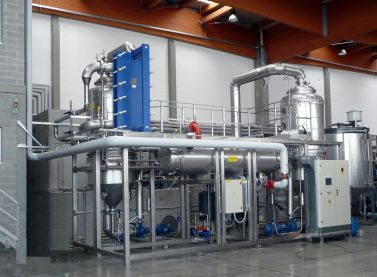 ENVIDEST MFE 2Double effect thermal vacuum evaporators by forced circulation
ENVIDEST MFE 2Double effect thermal vacuum evaporators by forced circulation ENVIDEST MFE 3Triple effect thermal vacuum evaporators by forced circulation
ENVIDEST MFE 3Triple effect thermal vacuum evaporators by forced circulation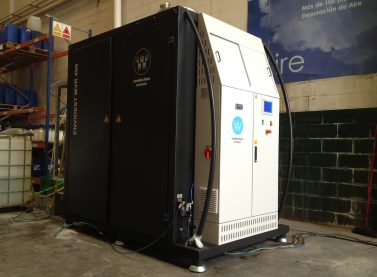 ENVIDEST MVR FFFalling film vacuum evaporators by mechanical vapour recompression and forced circulation
ENVIDEST MVR FFFalling film vacuum evaporators by mechanical vapour recompression and forced circulation ENVIDEST DPM 1Single effect thermal vacuum evaporators
ENVIDEST DPM 1Single effect thermal vacuum evaporators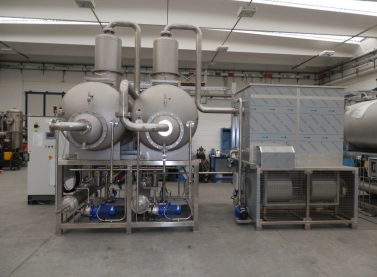 ENVIDEST DPM 2Double effect thermal vacuum evaporators
ENVIDEST DPM 2Double effect thermal vacuum evaporators ENVIDEST DPM 3Third effect thermal vacuum evaporators
ENVIDEST DPM 3Third effect thermal vacuum evaporators ENVIDEST LT VSHeat pump vacuum evaporators
ENVIDEST LT VSHeat pump vacuum evaporators ENVIDEST EAAtmospheric evaporators
ENVIDEST EAAtmospheric evaporators DESALT LT DRYHeat pump vacuum crystallizers
DESALT LT DRYHeat pump vacuum crystallizers DESALT LT VRHeat pump vacuum crystallizers
DESALT LT VRHeat pump vacuum crystallizers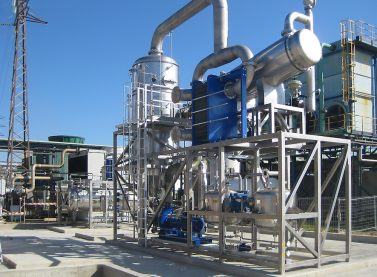 DESALT MFEThermal vacuum crystallizers by forced circulation
DESALT MFEThermal vacuum crystallizers by forced circulation DESALT VRThermal vacuum crystallizers
DESALT VRThermal vacuum crystallizers DESALT MVR FCVacuum crystallizers by mechanical vapour recompression and forced circulation
DESALT MVR FCVacuum crystallizers by mechanical vapour recompression and forced circulation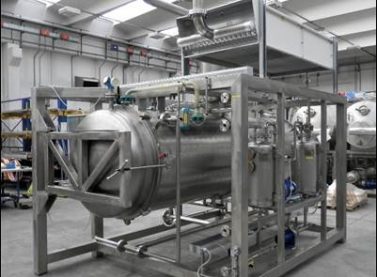 DESALT DRYThermal vacuum crystallizers
DESALT DRYThermal vacuum crystallizersConcept (need and benefits)
Industrial processes often generate liquid waste that cannot be discharged directly to the environment or to the public sanitation network. In addition, this liquid waste is sometimes difficult to purify by conventional treatments due to the nature of some of the contaminants. The difficulty with treatment may be caused by a high concentration of pollutants, the residue not having an aqueous base, the presence of volatile organic compounds or by a combination of these or other causes.
Whatever the case, a treatment compatible with the type of liquid waste must be used to ensure the treated effluent can be discharged in compliance with current regulations. And, in the most ambitious cases, so that the effluent can be recovered and reused. This is the case with certain organic compounds (alcohols and organic solvents). In addition to their being unable to be discharged without prior treatment due to their high polluting potential, their re-use can lead to high economic savings that motivate the need for treatment. This saving is twofold, as it is derived from savings in purchasing new raw material and from the reduction in external waste management costs.
Types of liquid waste
There is a wide variety of industrial liquid waste, with the type requiring greater treatment difficulties usually being that for which conventional processes are ineffective. This is the case with the following liquid waste:
- Spent liquors
- Effluents of aqueous-based emulsions of oils and fats
- Leachate
- Galvanic plating rinsing water
- Degreasing and phosphating water
- Water with a high concentration of heavy metals
- Water with a high concentration of salts
- Wash water from the chemical and cosmetic industry
Industries and applications
A wide variety of industrial sectors produce liquid waste. The ones listed below usually generate complex liquid waste whose most competitive options for treatment are those indicated above:
- Food industry: Extraction of oils and fats, using solvents such as cyclohexane and carbon disulfide.
- Iron and steel industry: Cleaning and degreasing parts, using trichlorethylene and methylene chloride. Also, aliphatic hydrocarbons are used for cooling in cutting processes.
- Footwear industry: The glues and adhesives used contain solvent that is usually a mixture of hexanes.
- Plastics and rubber industry. As a raw materials and transformation solvent, dimethylformamide, chloroform and acetone are often used.
- Timber industry: Solvents for lacquers and varnishes usually use white spirits (or turpentine) and toluene.
- Cosmetics industry. Ethyl alcohol, isopropyl alcohol and chloroform are used as a dispersant.
- Pharmaceutical industry: Complex liquid waste is produced in the synthesis of formulas; in many cases, with organic compounds.
- Painting industry: Toluene, acetates, ketones, etc. are usually used as diluents.
- Dry cleaning: The use of tetrachlorethylene is widespread as solvent for organic substances.
- Liquid paint: Organic solvents are used in numerous industries (e.g. vehicle bodywork, industrial paint and paint manufacturing).
- Metal sector: Penetrating agents and emulsions with organic compounds are used in the auxiliary sector of the automobile and aeronautics sector.
- In the cosmetic, chemical and pharmaceutical industries: a great variety of complex liquid waste is produced, generally in the washing of equipment and facilities.
- Textiles: In the dyeing processes of clothing and printing, liquid waste containing pigments and coloring products is generated.